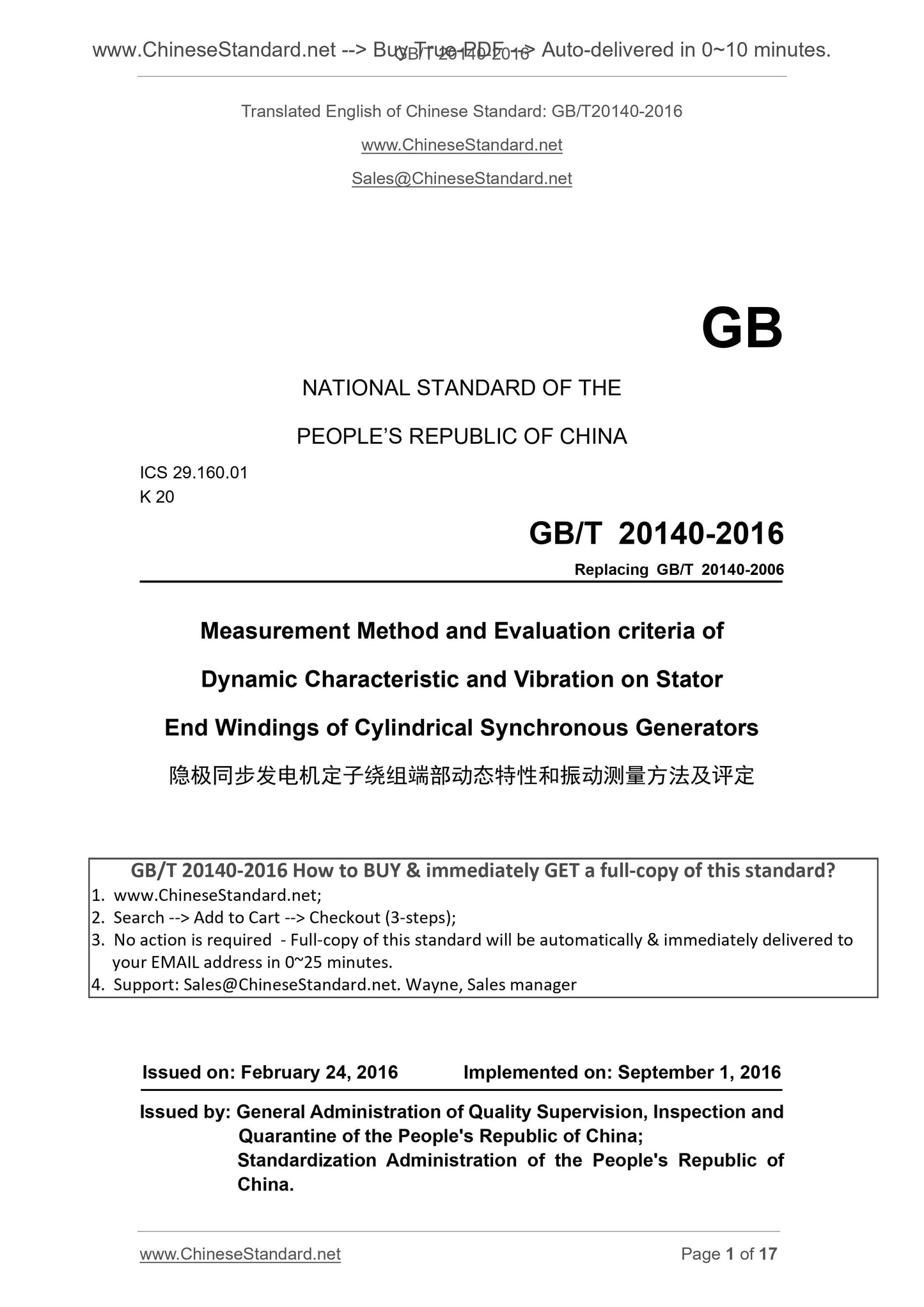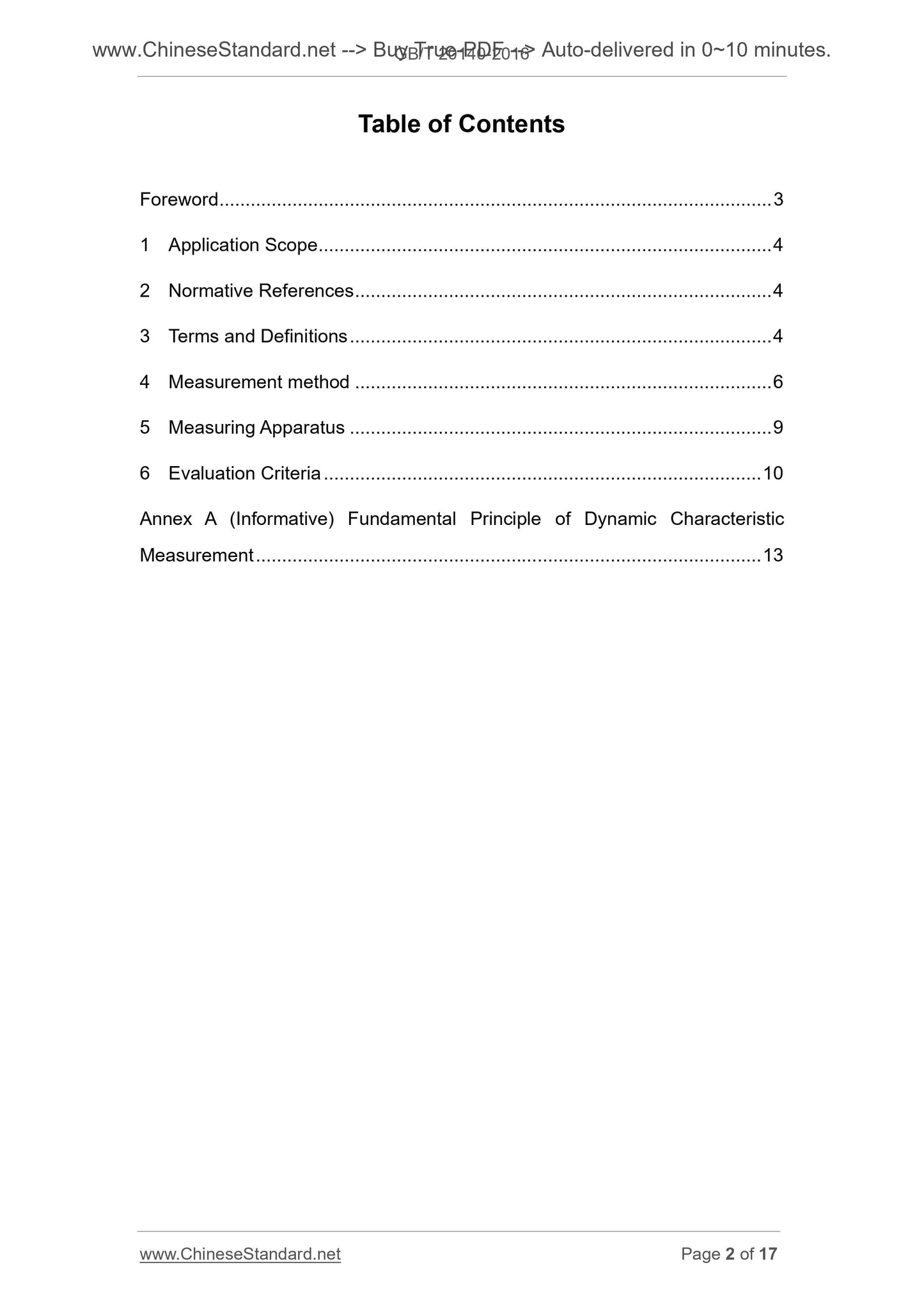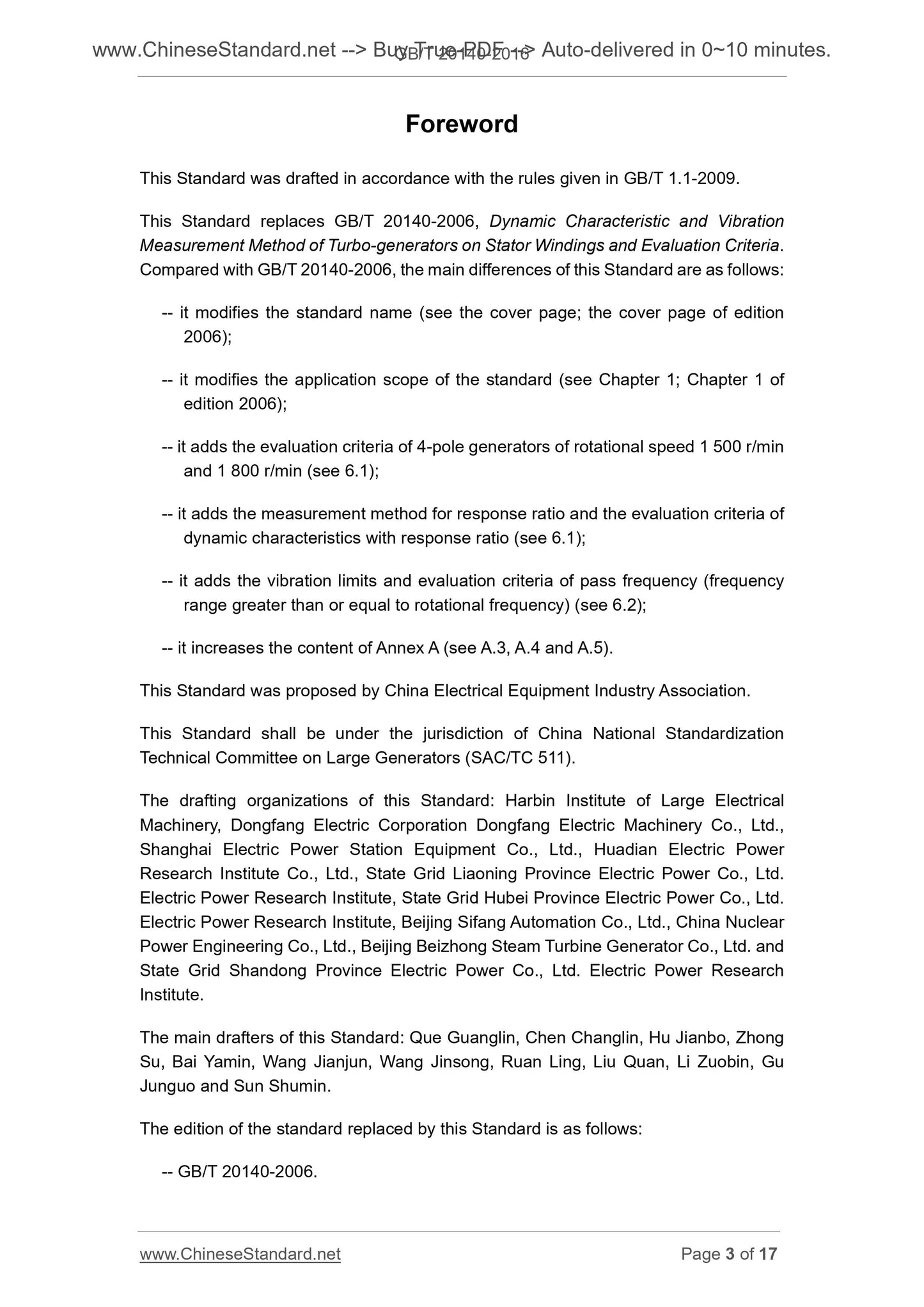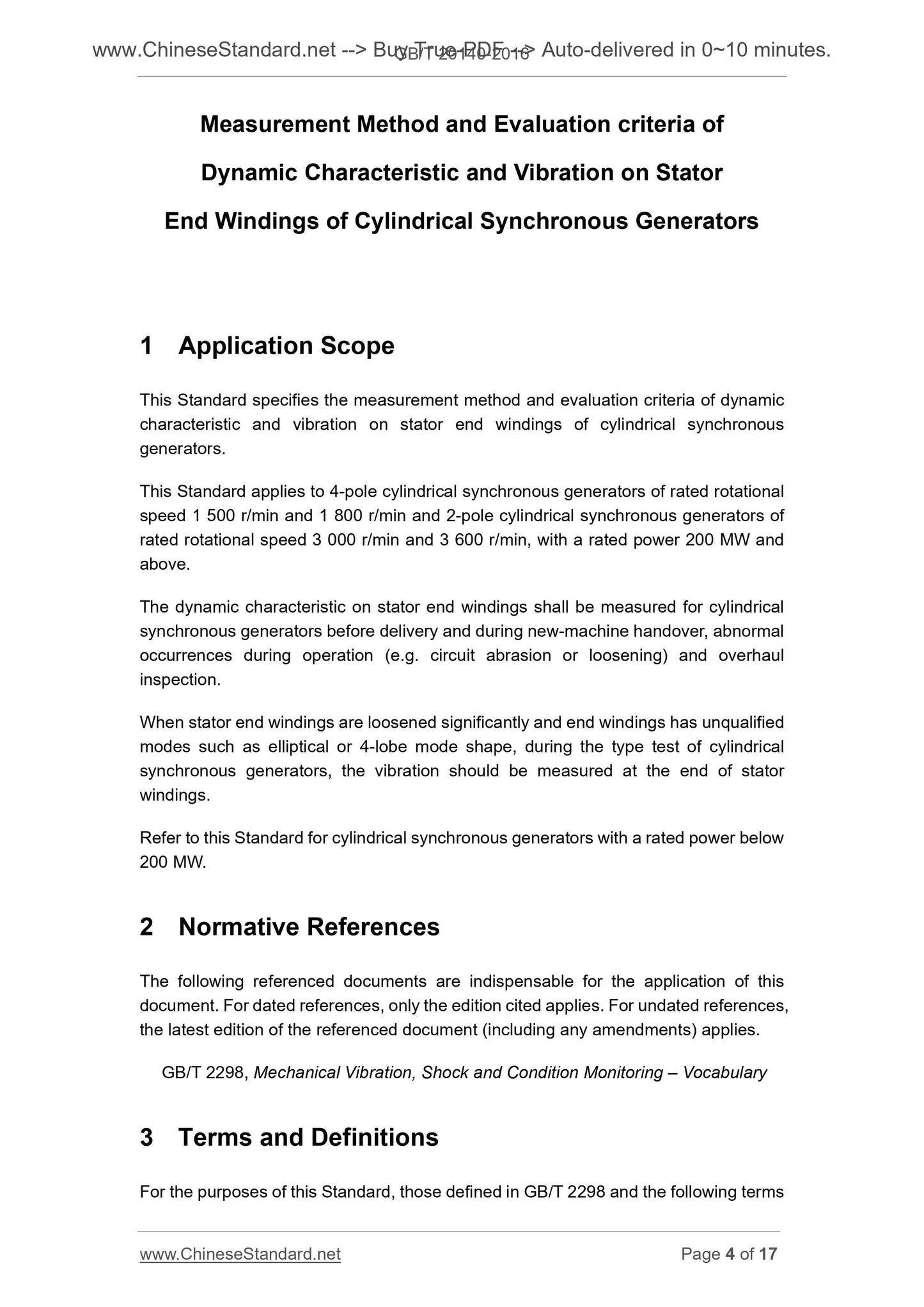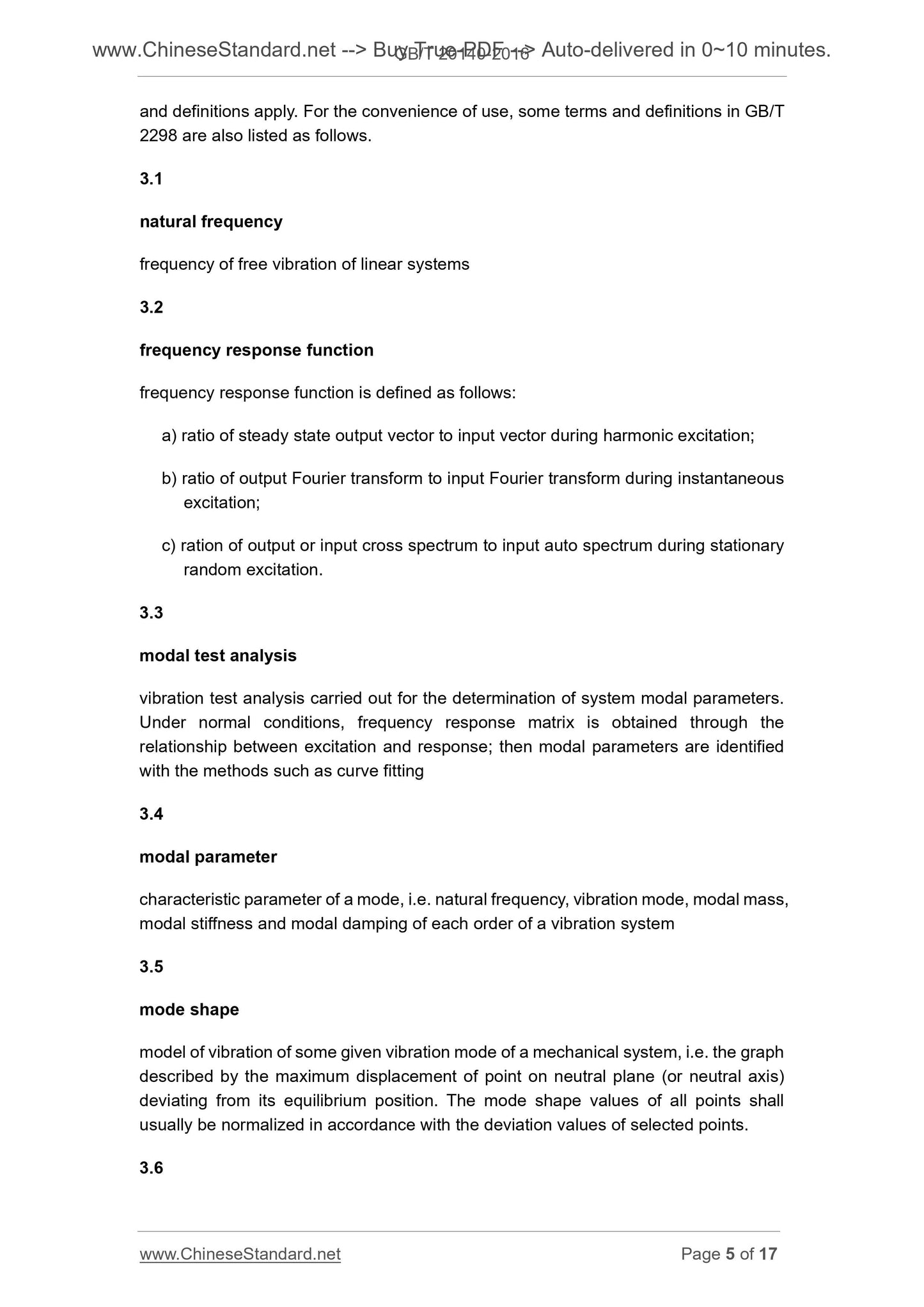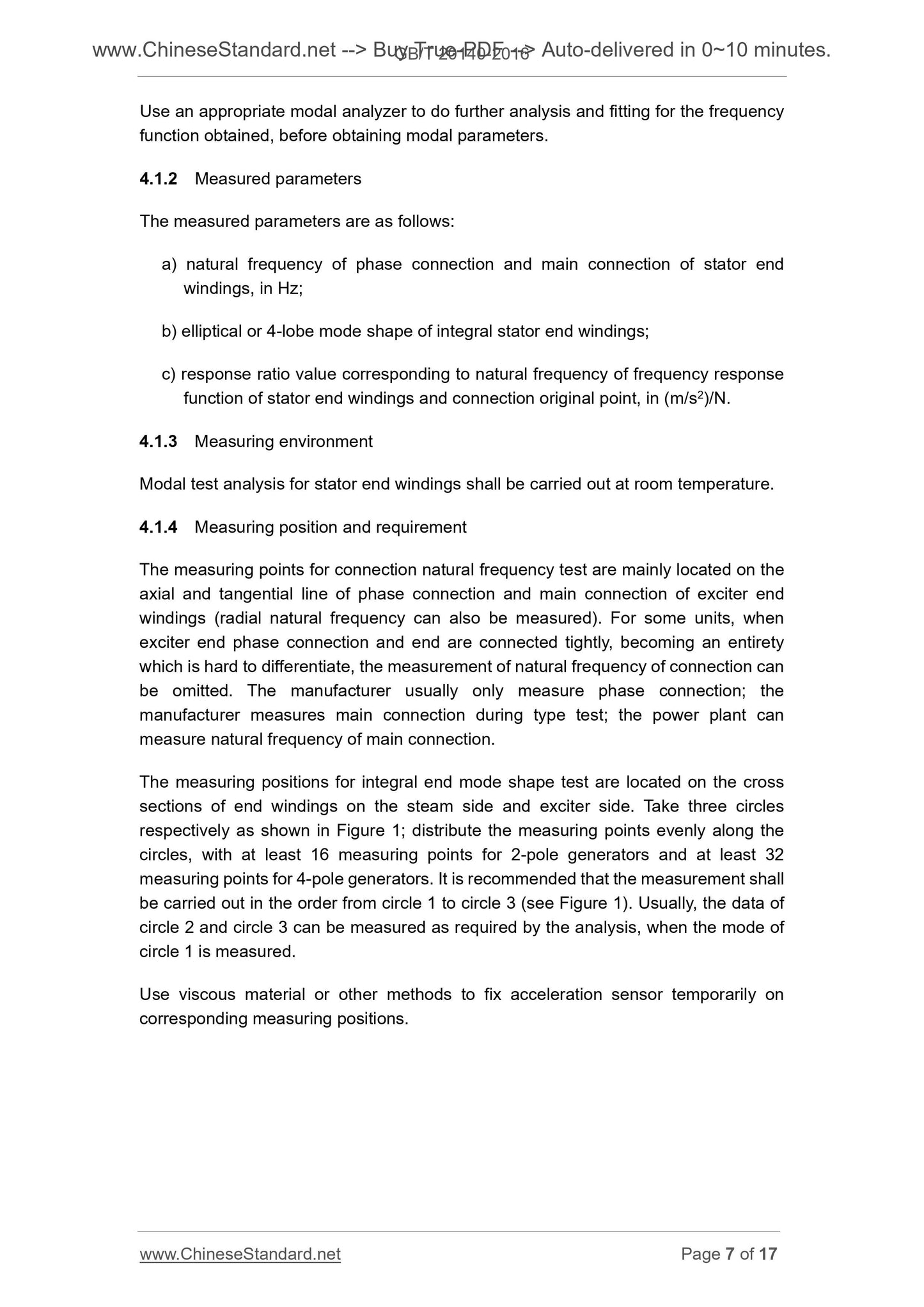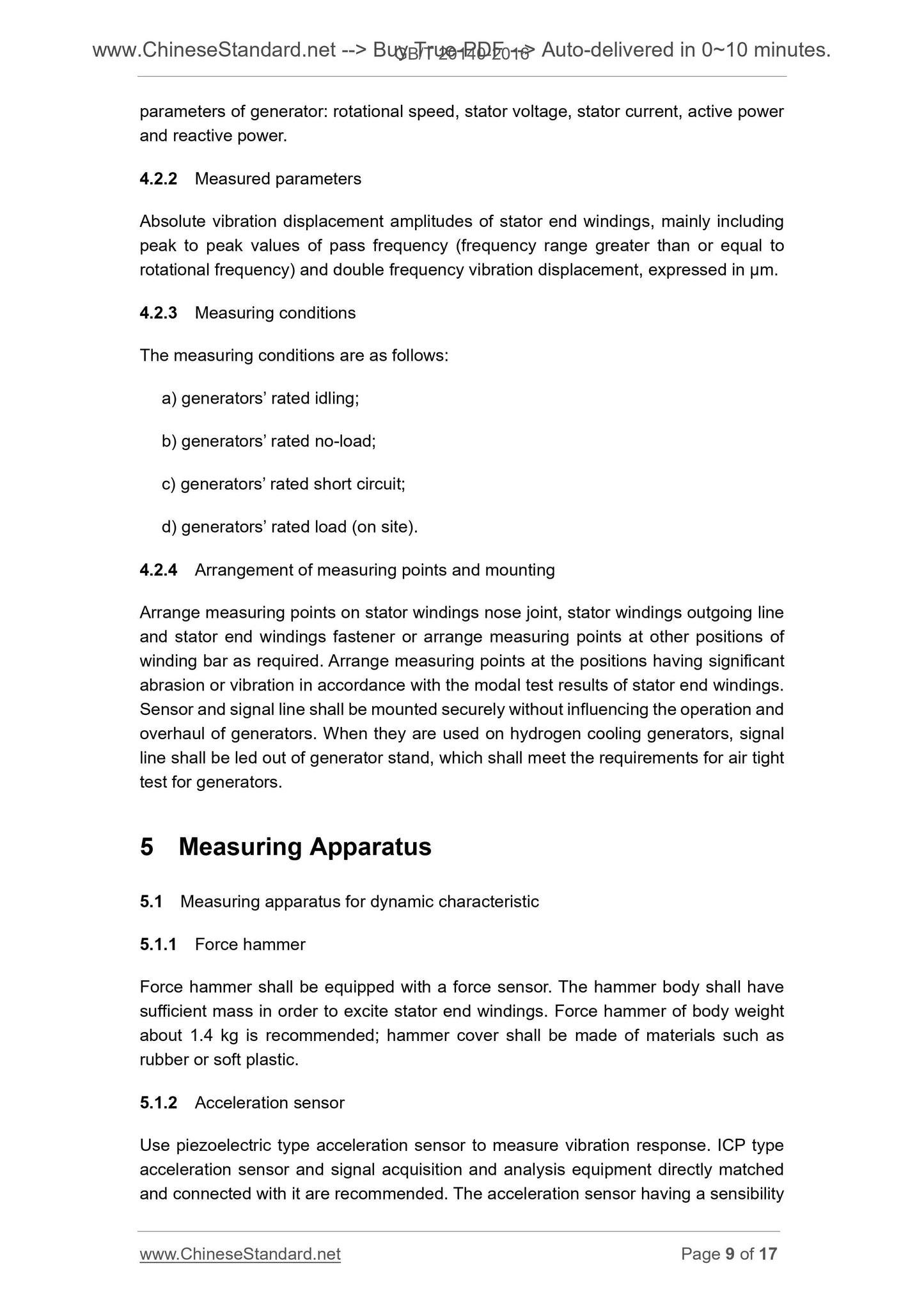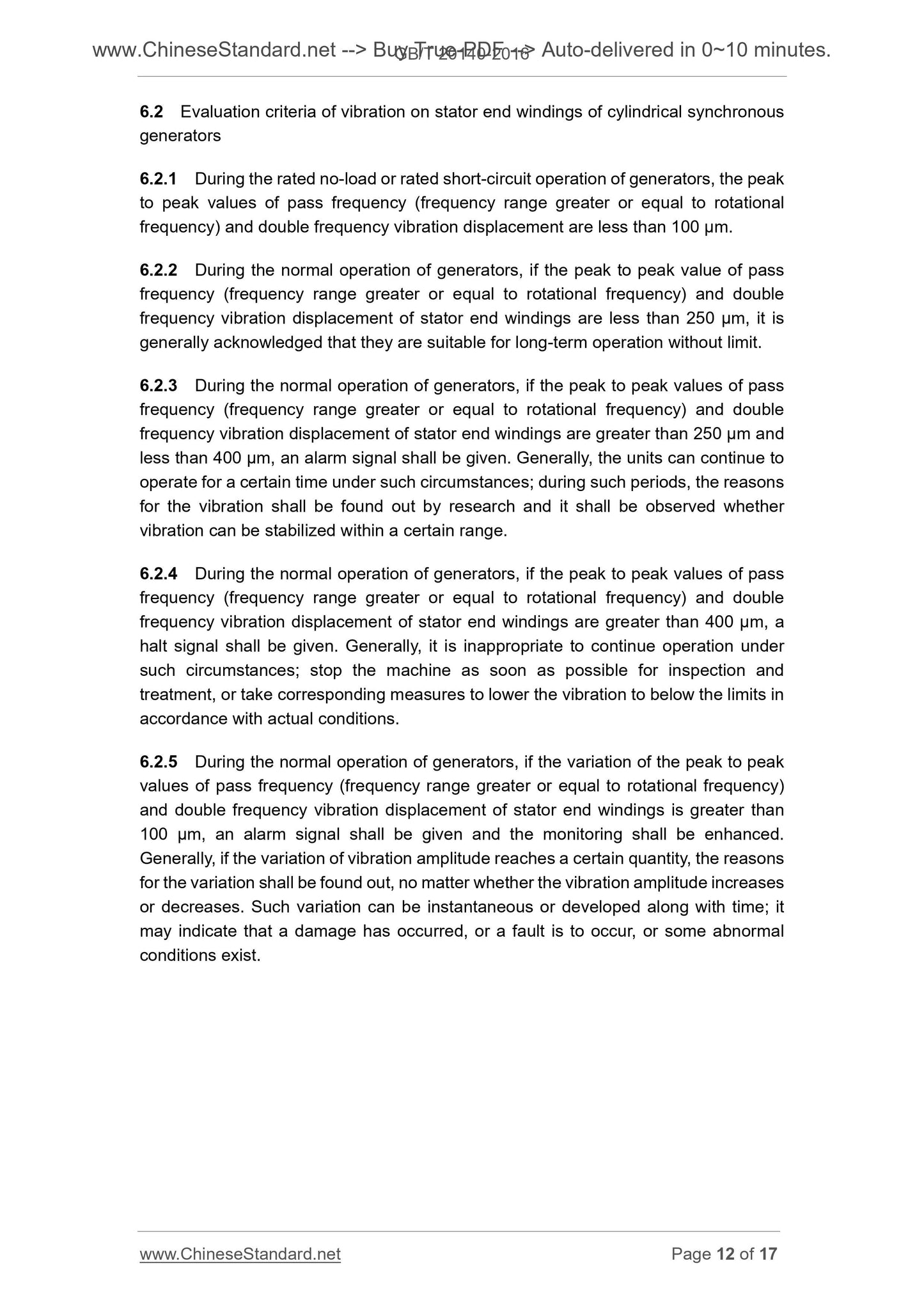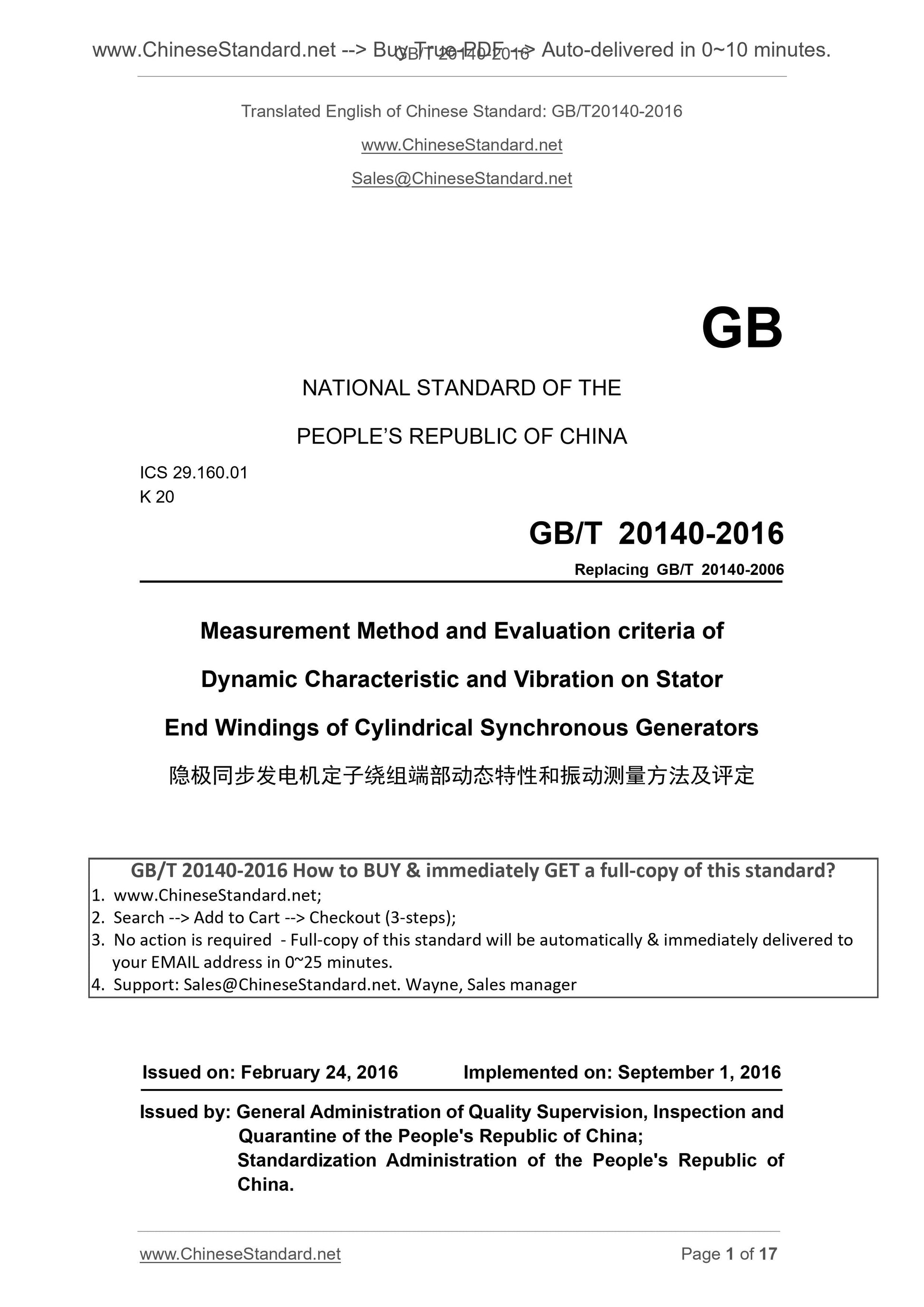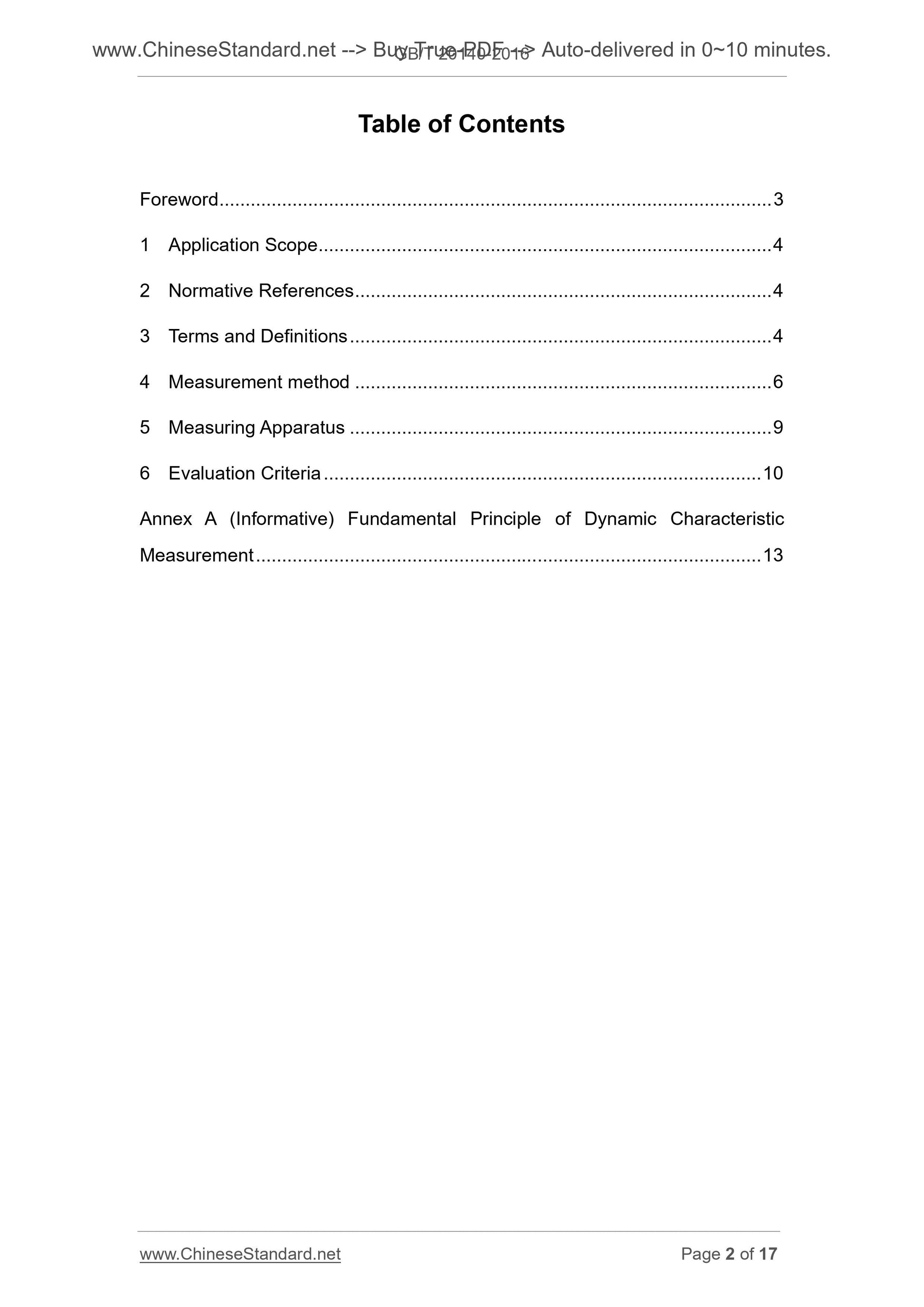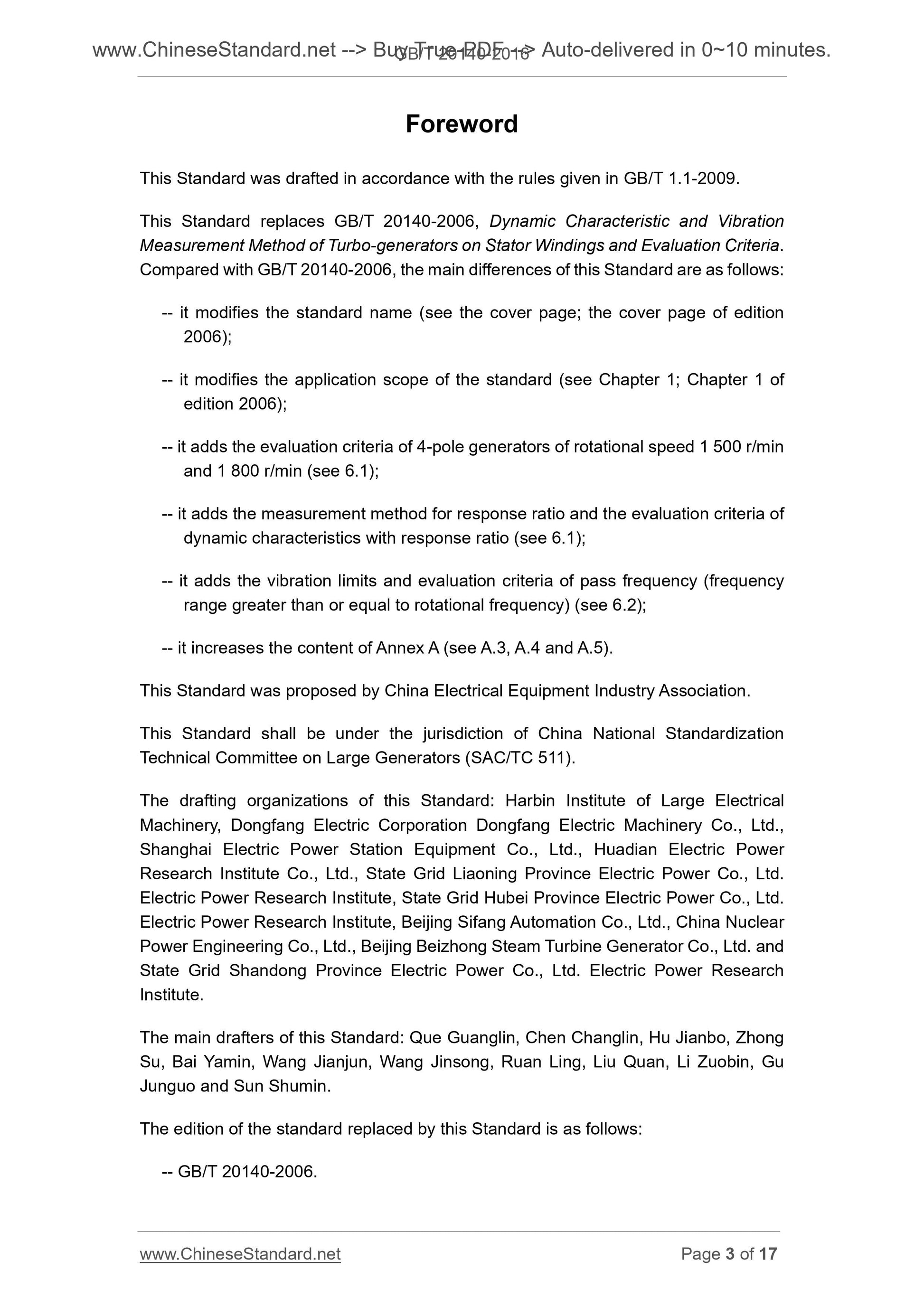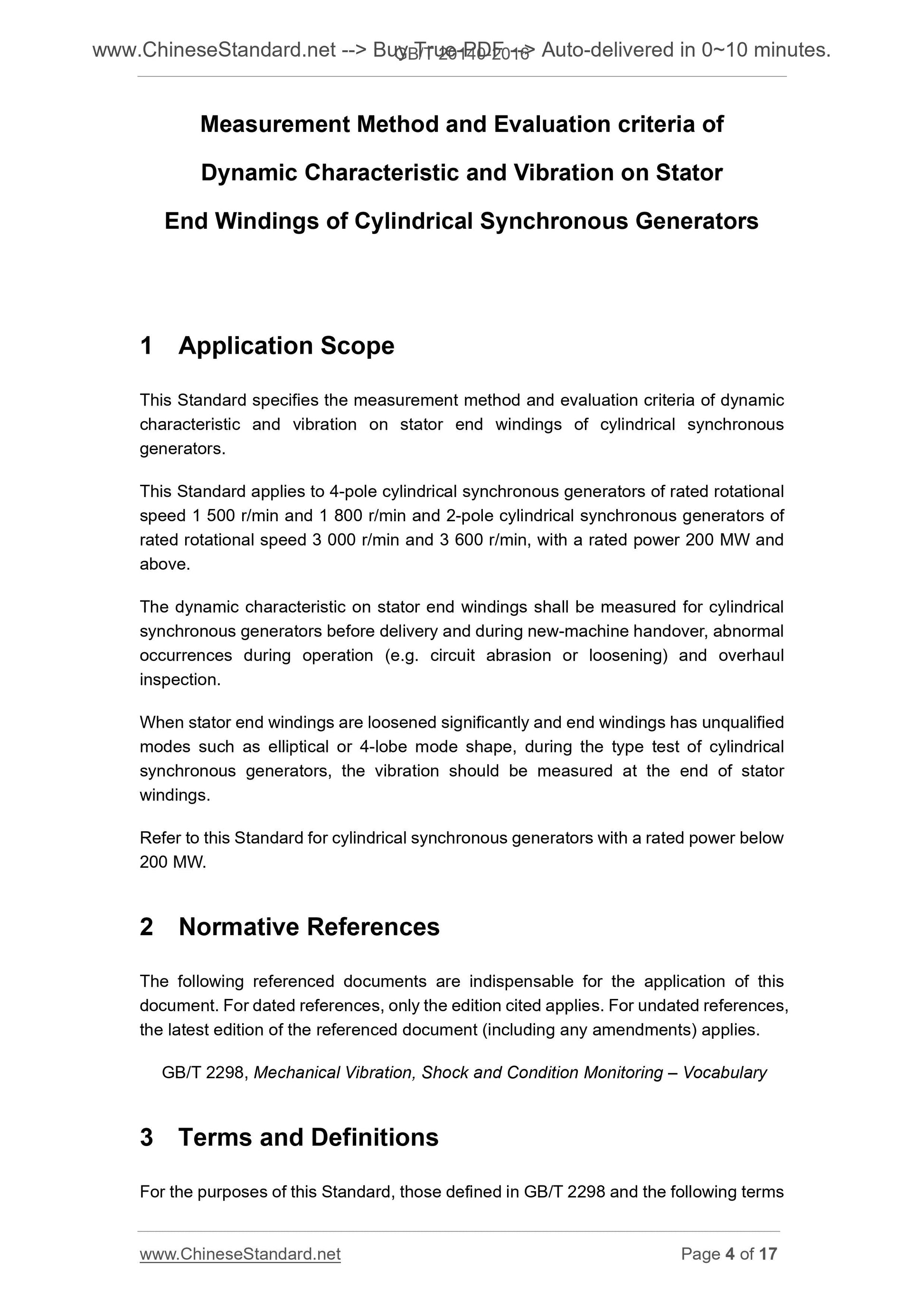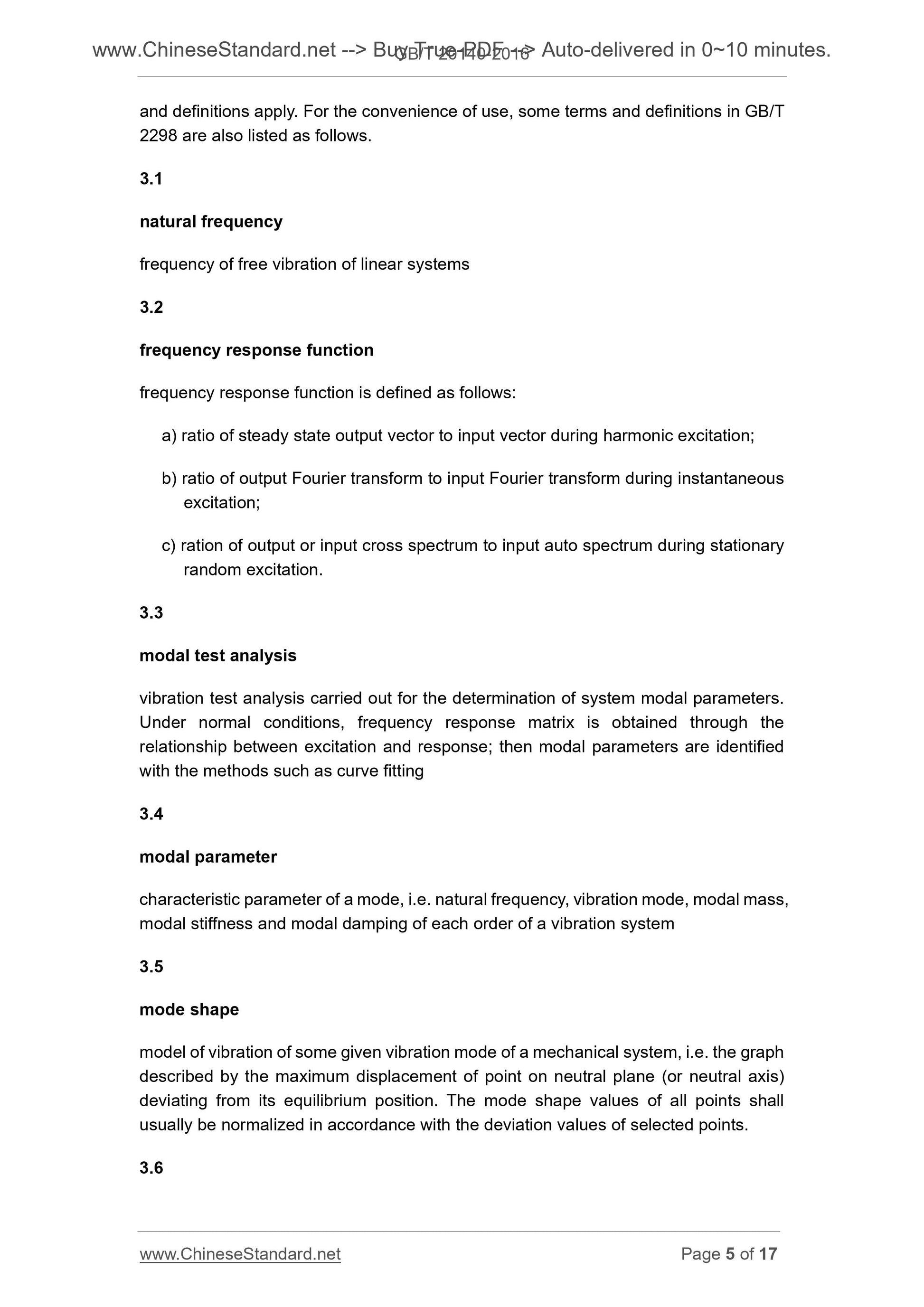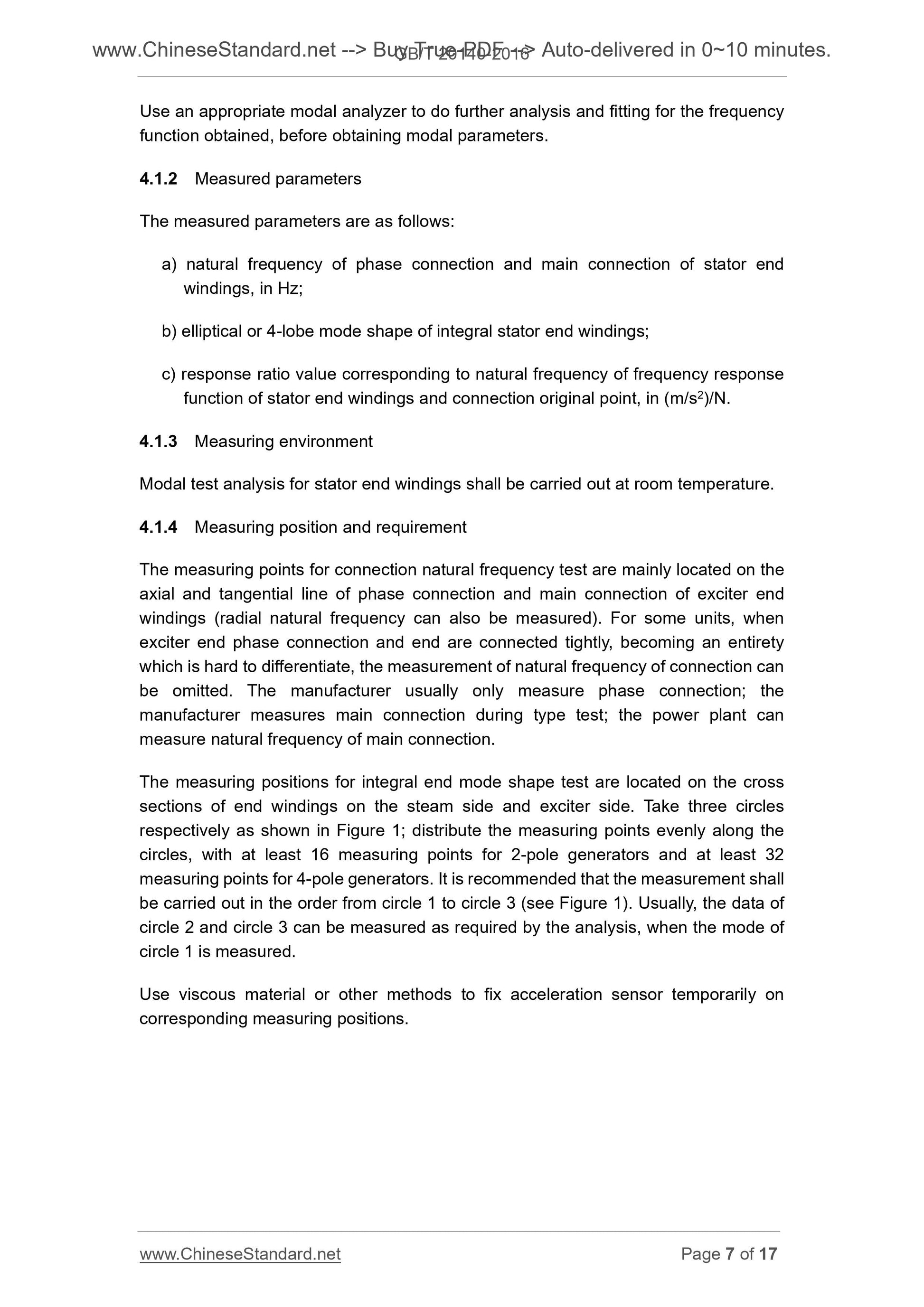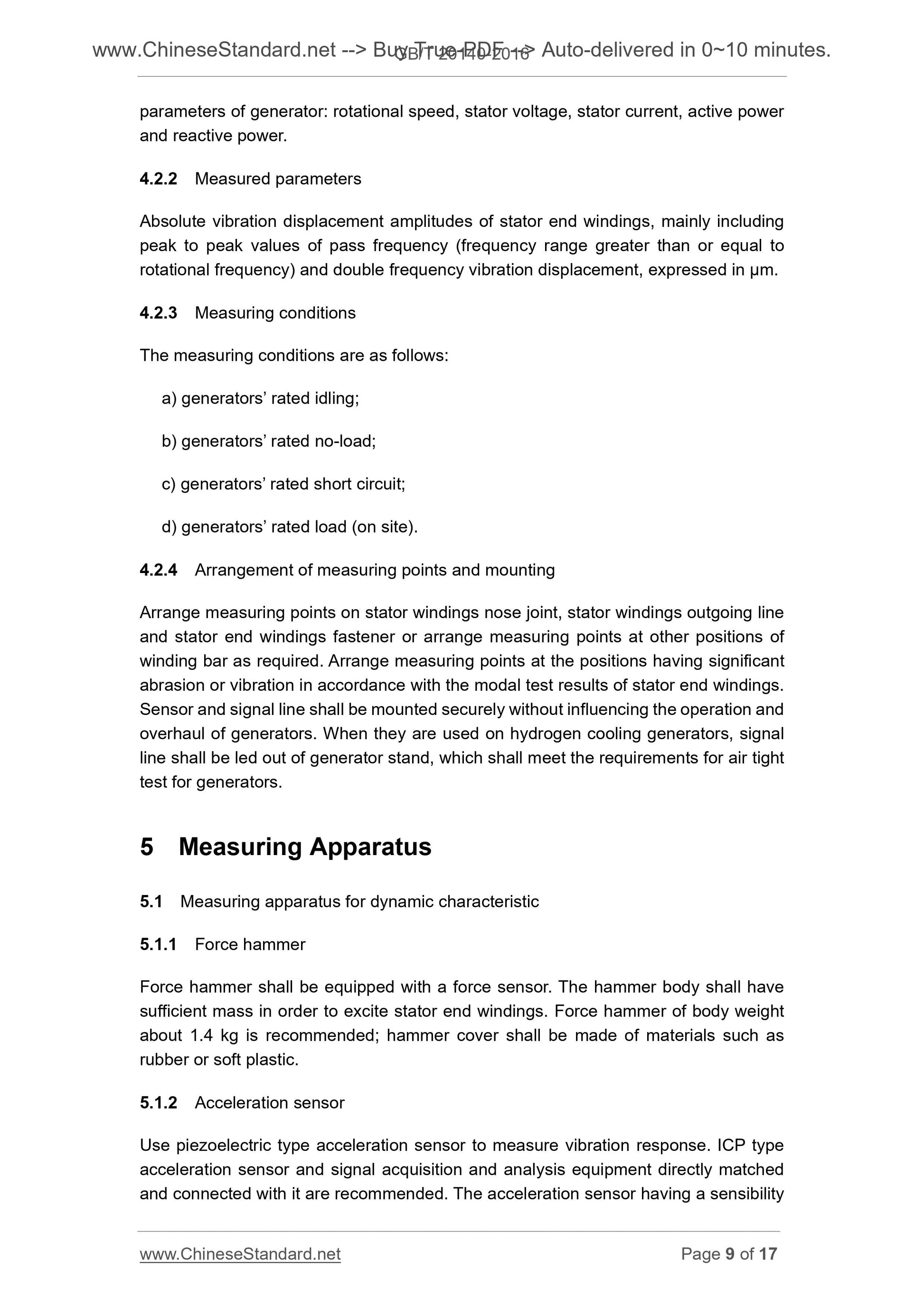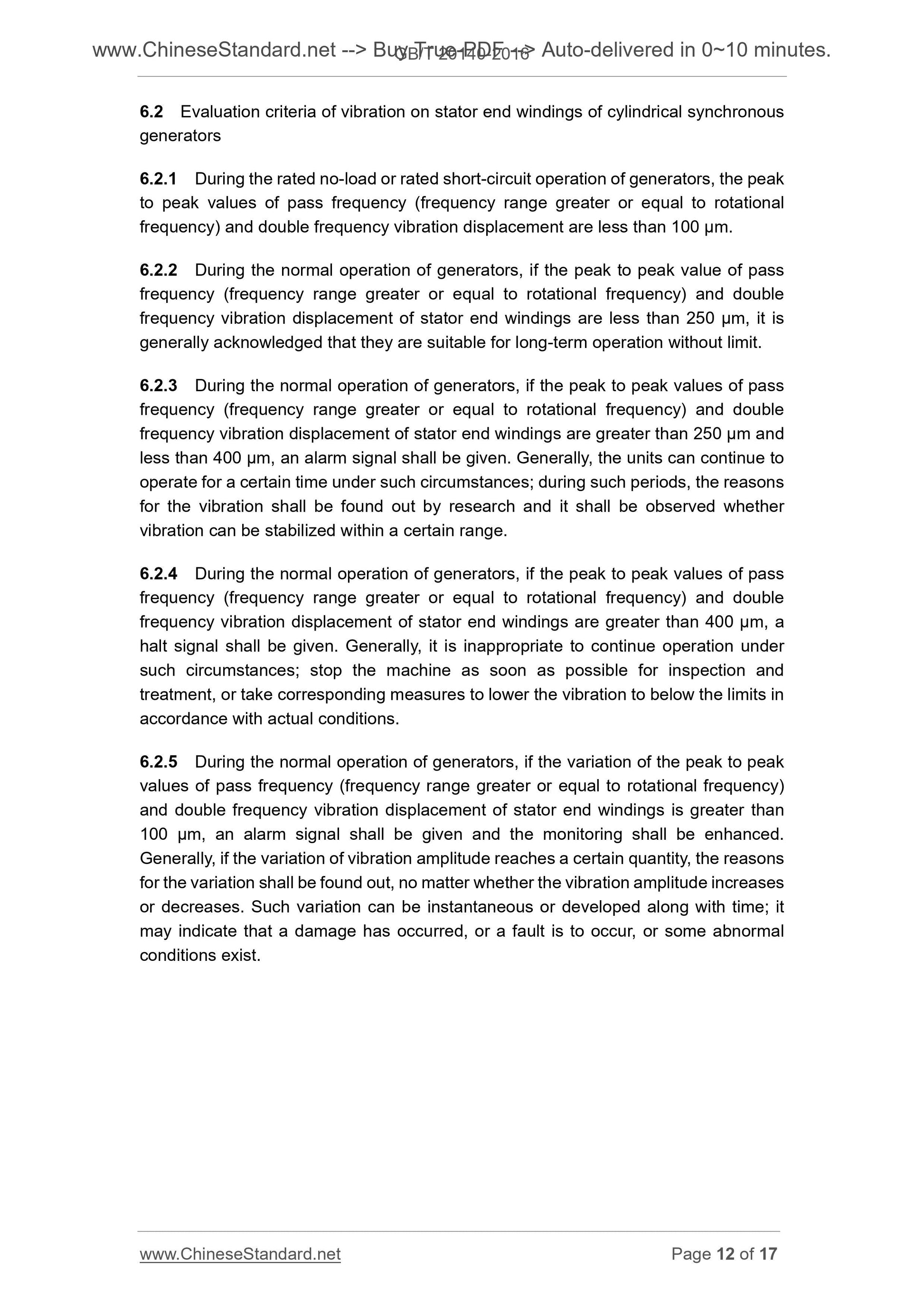1
/
of
8
www.ChineseStandard.us -- Field Test Asia Pte. Ltd.
GB/T 20140-2016 English PDF (GB/T20140-2016)
GB/T 20140-2016 English PDF (GB/T20140-2016)
Regular price
$130.00
Regular price
Sale price
$130.00
Unit price
/
per
Shipping calculated at checkout.
Couldn't load pickup availability
GB/T 20140-2016: Measurement Method and Evaluation criteria of Dynamic Characteristic and Vibration on Stator End Windings of Cylindrical Synchronous Generators
Delivery: 9 seconds. Download (& Email) true-PDF + Invoice.
Get Quotation: Click GB/T 20140-2016 (Self-service in 1-minute)
Historical versions (Master-website): GB/T 20140-2016
Preview True-PDF (Reload/Scroll-down if blank)
GB/T 20140-2016
GB
NATIONAL STANDARD OF THE
PEOPLE’S REPUBLIC OF CHINA
ICS 29.160.01
K 20
Replacing GB/T 20140-2006
Measurement Method and Evaluation criteria of
Dynamic Characteristic and Vibration on Stator
End Windings of Cylindrical Synchronous Generators
ISSUED ON. FEBRUARY 24, 2016
IMPLEMENTED ON. SEPTEMBER 1, 2016
Issued by. General Administration of Quality Supervision, Inspection and
Quarantine of the People's Republic of China;
Standardization Administration of the People's Republic of
China.
Table of Contents
Foreword ... 3
1 Application Scope ... 4
2 Normative References ... 4
3 Terms and Definitions ... 4
4 Measurement method ... 6
5 Measuring Apparatus ... 9
6 Evaluation Criteria ... 10
Annex A (Informative) Fundamental Principle of Dynamic Characteristic
Measurement ... 13
Foreword
This Standard was drafted in accordance with the rules given in GB/T 1.1-2009.
This Standard replaces GB/T 20140-2006, Dynamic Characteristic and Vibration
Measurement Method of Turbo-generators on Stator Windings and Evaluation Criteria.
Compared with GB/T 20140-2006, the main differences of this Standard are as follows.
-- it modifies the standard name (see the cover page; the cover page of edition
2006);
-- it modifies the application scope of the standard (see Chapter 1; Chapter 1 of
edition 2006);
-- it adds the evaluation criteria of 4-pole generators of rotational speed 1 500 r/min
and 1 800 r/min (see 6.1);
-- it adds the measurement method for response ratio and the evaluation criteria of
dynamic characteristics with response ratio (see 6.1);
-- it adds the vibration limits and evaluation criteria of pass frequency (frequency
range greater than or equal to rotational frequency) (see 6.2);
-- it increases the content of Annex A (see A.3, A.4 and A.5).
This Standard was proposed by China Electrical Equipment Industry Association.
This Standard shall be under the jurisdiction of China National Standardization
Technical Committee on Large Generators (SAC/TC 511).
The drafting organizations of this Standard. Harbin Institute of Large Electrical
Machinery, Dongfang Electric Corporation Dongfang Electric Machinery Co., Ltd.,
Shanghai Electric Power Station Equipment Co., Ltd., Huadian Electric Power
Research Institute Co., Ltd., State Grid Liaoning Province Electric Power Co., Ltd.
Electric Power Research Institute, State Grid Hubei Province Electric Power Co., Ltd.
Electric Power Research Institute, Beijing Sifang Automation Co., Ltd., China Nuclear
Power Engineering Co., Ltd., Beijing Beizhong Steam Turbine Generator Co., Ltd. and
State Grid Shandong Province Electric Power Co., Ltd. Electric Power Research
Institute.
The main drafters of this Standard. Que Guanglin, Chen Changlin, Hu Jianbo, Zhong
Su, Bai Yamin, Wang Jianjun, Wang Jinsong, Ruan Ling, Liu Quan, Li Zuobin, Gu
Junguo and Sun Shumin.
The edition of the standard replaced by this Standard is as follows.
-- GB/T 20140-2006.
Measurement Method and Evaluation criteria of
Dynamic Characteristic and Vibration on Stator
End Windings of Cylindrical Synchronous Generators
1 Application Scope
This Standard specifies the measurement method and evaluation criteria of dynamic
characteristic and vibration on stator end windings of cylindrical synchronous
generators.
This Standard applies to 4-pole cylindrical synchronous generators of rated rotational
speed 1 500 r/min and 1 800 r/min and 2-pole cylindrical synchronous generators of
rated rotational speed 3 000 r/min and 3 600 r/min, with a rated power 200 MW and
above.
The dynamic characteristic on stator end windings shall be measured for cylindrical
synchronous generators before delivery and during new-machine handover, abnormal
occurrences during operation (e.g. circuit abrasion or loosening) and overhaul
inspection.
When stator end windings are loosened significantly and end windings has unqualified
modes such as elliptical or 4-lobe mode shape, during the type test of cylindrical
synchronous generators, the vibration should be measured at the end of stator
windings.
Refer to this Standard for cylindrical synchronous generators with a rated power below
200 MW.
2 Normative References
The following referenced documents are indispensable for the application of this
document. For dated references, only the edition cited applies. For undated references,
the latest edition of the referenced document (including any amendments) applies.
GB/T 2298, Mechanical Vibration, Shock and Condition Monitoring – Vocabulary
3 Terms and Definitions
For the purposes of this Standard, those defined in GB/T 2298 and the following terms
and definitions apply. For the convenience of use, some terms and definitions in GB/T
2298 are also listed as follows.
3.1
natural frequency
frequency of free vibration of linear systems
3.2
frequency response function
frequency response function is defined as follows.
a) ratio of steady state output vector to input vector during harmonic excitation;
b) ratio of output Fourier transform to input Fourier transform during instantaneous
excitation;
c) ration of output or input cross spectrum to input auto spectrum during stationary
random excitation.
3.3
modal test analysis
vibration test analysis carried out for the determination of system modal parameters.
Under normal conditions, frequency response matrix is obtained through the
relationship between excitation and response; then modal parameters are identified
with the methods such as curve fitting
3.4
modal parameter
characteristic parameter of a mode, i.e. natural frequency, vibration mode, modal mass,
modal stiffness and modal damping of each order of a vibration system
3.5
mode shape
model of vibration of some given vibration mode of a mechanical system, i.e. the graph
described by the maximum displacement of point on neutral plane (or neutral axis)
deviating from its equilibrium position. The mode shape values of all points shall
usually be normalized in accordance with the deviation values of selected points.
3.6
Use an appropriate modal analyzer to do further analysis and fitting for the frequency
function obtained, before obtaining modal parameters.
4.1.2 Measured parameters
The measured parameters are as follows.
a) natural frequency of phase connection and main connection of stator end
windings, in Hz;
b) elliptical or 4-lobe mode shape of integral stator end windings;
c) response ratio value corresponding to natural frequency of frequency response
function of stator end windings and connection original point, in (m/s2)/N.
4.1.3 Measuring environment
Modal test analysis for stator end windings shall be carried out at room temperature.
4.1.4 Measuring position and requirement
The measuring points for connection natural frequency test are mainly located on the
axial and tangential line of phase connection and main connection of exciter end
windings (radial natural frequency can also be measured). For some units, when
exciter end phase connection and end are connected tightly, becoming an entirety
which is hard to differentiate, the measurement of natural frequency of connection can
be omitted. The manufacturer usually only measure phase connection; the
manufacturer measures main connection during type test; the power plant can
measure natural frequency of main connection.
The measuring positions for integral end mode shape test are located on the cross
sections of end windings on the steam side and exciter side. Take three circles
respectively as shown in Figure 1; distribute the measuring points evenly along the
circles, with at least 16 measuring points for 2-pole generators and at least 32
measuring points for 4-pole generators. It is recommended that the measurement shall
be carried out in the order from circle 1 to circle 3 (see Figure 1). Usually, the data of
circle 2 and circle 3 can be measured as required by the analysis, when the mode of
circle 1 is measured.
Use viscous material or other methods to fix acceleration sensor temporarily on
corresponding measuring positions.
parameters of generator. rotational speed, stator voltage, stator current, active power
and reactive power.
4.2.2 Measured parameters
Absolute vibration displacement amplitudes of stator end windings, mainly including
peak to peak values of pass frequency (frequency range greater than or equal to
rotational frequency) and double frequency vibration displacement, expressed in μm.
4.2.3 Measuring conditions
The measuring conditions are as follows.
a) generators’ rated idling;
b) generators’ rated no-load;
c) generators’ rated short circuit;
d) generators’ rated load (on site).
4.2.4 Arrangement of measuring points and mounting
Arrange measuring points on stator windings nose joint, stator windings outgoing line
and stator end windings fastener or arrange measuring points at other positions of
winding bar as required. Arrange measuring points at the positions having significant
abrasion or vibration in accordance with the modal test...
GB/T 20140-2016
GB
NATIONAL STANDARD OF THE
PEOPLE’S REPUBLIC OF CHINA
ICS 29.160.01
K 20
Replacing GB/T 20140-2006
Measurement Method and Evaluation criteria of
Dynamic Characteristic and Vibration on Stator
End Windings of Cylindrical Synchronous Generators
ISSUED ON. FEBRUARY 24, 2016
IMPLEMENTED ON. SEPTEMBER 1, 2016
Issued by. General Administration of Quality Supervision, Inspection and
Quarantine of the People's Republic of China;
Standardization Administration of the People's Republic of
China.
Table of Contents
Foreword ... 3
1 Application Scope ... 4
2 Normative References ... 4
3 Terms and Definitions ... 4
4 Measurement method ... 6
5 Measuring Apparatus ... 9
6 Evaluation Criteria ... 10
Annex A (Informative) Fundamental Principle of Dynamic Characteristic
Measurement ... 13
Foreword
This Standard was drafted in accordance with the rules given in GB/T 1.1-2009.
This Standard replaces GB/T 20140-2006, Dynamic Characteristic and Vibration
Measurement Method of Turbo-generators on Stator Windings and Evaluation Criteria.
Compared with GB/T 20140-2006, the main differences of this Standard are as follows.
-- it modifies the standard name (see the cover page; the cover page of edition
2006);
-- it modifies the application scope of the standard (see Chapter 1; Chapter 1 of
edition 2006);
-- it adds the evaluation criteria of 4-pole generators of rotational speed 1 500 r/min
and 1 800 r/min (see 6.1);
-- it adds the measurement method for response ratio and the evaluation criteria of
dynamic characteristics with response ratio (see 6.1);
-- it adds the vibration limits and evaluation criteria of pass frequency (frequency
range greater than or equal to rotational frequency) (see 6.2);
-- it increases the content of Annex A (see A.3, A.4 and A.5).
This Standard was proposed by China Electrical Equipment Industry Association.
This Standard shall be under the jurisdiction of China National Standardization
Technical Committee on Large Generators (SAC/TC 511).
The drafting organizations of this Standard. Harbin Institute of Large Electrical
Machinery, Dongfang Electric Corporation Dongfang Electric Machinery Co., Ltd.,
Shanghai Electric Power Station Equipment Co., Ltd., Huadian Electric Power
Research Institute Co., Ltd., State Grid Liaoning Province Electric Power Co., Ltd.
Electric Power Research Institute, State Grid Hubei Province Electric Power Co., Ltd.
Electric Power Research Institute, Beijing Sifang Automation Co., Ltd., China Nuclear
Power Engineering Co., Ltd., Beijing Beizhong Steam Turbine Generator Co., Ltd. and
State Grid Shandong Province Electric Power Co., Ltd. Electric Power Research
Institute.
The main drafters of this Standard. Que Guanglin, Chen Changlin, Hu Jianbo, Zhong
Su, Bai Yamin, Wang Jianjun, Wang Jinsong, Ruan Ling, Liu Quan, Li Zuobin, Gu
Junguo and Sun Shumin.
The edition of the standard replaced by this Standard is as follows.
-- GB/T 20140-2006.
Measurement Method and Evaluation criteria of
Dynamic Characteristic and Vibration on Stator
End Windings of Cylindrical Synchronous Generators
1 Application Scope
This Standard specifies the measurement method and evaluation criteria of dynamic
characteristic and vibration on stator end windings of cylindrical synchronous
generators.
This Standard applies to 4-pole cylindrical synchronous generators of rated rotational
speed 1 500 r/min and 1 800 r/min and 2-pole cylindrical synchronous generators of
rated rotational speed 3 000 r/min and 3 600 r/min, with a rated power 200 MW and
above.
The dynamic characteristic on stator end windings shall be measured for cylindrical
synchronous generators before delivery and during new-machine handover, abnormal
occurrences during operation (e.g. circuit abrasion or loosening) and overhaul
inspection.
When stator end windings are loosened significantly and end windings has unqualified
modes such as elliptical or 4-lobe mode shape, during the type test of cylindrical
synchronous generators, the vibration should be measured at the end of stator
windings.
Refer to this Standard for cylindrical synchronous generators with a rated power below
200 MW.
2 Normative References
The following referenced documents are indispensable for the application of this
document. For dated references, only the edition cited applies. For undated references,
the latest edition of the referenced document (including any amendments) applies.
GB/T 2298, Mechanical Vibration, Shock and Condition Monitoring – Vocabulary
3 Terms and Definitions
For the purposes of this Standard, those defined in GB/T 2298 and the following terms
and definitions apply. For the convenience of use, some terms and definitions in GB/T
2298 are also listed as follows.
3.1
natural frequency
frequency of free vibra...
Delivery: 9 seconds. Download (& Email) true-PDF + Invoice.
Get Quotation: Click GB/T 20140-2016 (Self-service in 1-minute)
Historical versions (Master-website): GB/T 20140-2016
Preview True-PDF (Reload/Scroll-down if blank)
GB/T 20140-2016
GB
NATIONAL STANDARD OF THE
PEOPLE’S REPUBLIC OF CHINA
ICS 29.160.01
K 20
Replacing GB/T 20140-2006
Measurement Method and Evaluation criteria of
Dynamic Characteristic and Vibration on Stator
End Windings of Cylindrical Synchronous Generators
ISSUED ON. FEBRUARY 24, 2016
IMPLEMENTED ON. SEPTEMBER 1, 2016
Issued by. General Administration of Quality Supervision, Inspection and
Quarantine of the People's Republic of China;
Standardization Administration of the People's Republic of
China.
Table of Contents
Foreword ... 3
1 Application Scope ... 4
2 Normative References ... 4
3 Terms and Definitions ... 4
4 Measurement method ... 6
5 Measuring Apparatus ... 9
6 Evaluation Criteria ... 10
Annex A (Informative) Fundamental Principle of Dynamic Characteristic
Measurement ... 13
Foreword
This Standard was drafted in accordance with the rules given in GB/T 1.1-2009.
This Standard replaces GB/T 20140-2006, Dynamic Characteristic and Vibration
Measurement Method of Turbo-generators on Stator Windings and Evaluation Criteria.
Compared with GB/T 20140-2006, the main differences of this Standard are as follows.
-- it modifies the standard name (see the cover page; the cover page of edition
2006);
-- it modifies the application scope of the standard (see Chapter 1; Chapter 1 of
edition 2006);
-- it adds the evaluation criteria of 4-pole generators of rotational speed 1 500 r/min
and 1 800 r/min (see 6.1);
-- it adds the measurement method for response ratio and the evaluation criteria of
dynamic characteristics with response ratio (see 6.1);
-- it adds the vibration limits and evaluation criteria of pass frequency (frequency
range greater than or equal to rotational frequency) (see 6.2);
-- it increases the content of Annex A (see A.3, A.4 and A.5).
This Standard was proposed by China Electrical Equipment Industry Association.
This Standard shall be under the jurisdiction of China National Standardization
Technical Committee on Large Generators (SAC/TC 511).
The drafting organizations of this Standard. Harbin Institute of Large Electrical
Machinery, Dongfang Electric Corporation Dongfang Electric Machinery Co., Ltd.,
Shanghai Electric Power Station Equipment Co., Ltd., Huadian Electric Power
Research Institute Co., Ltd., State Grid Liaoning Province Electric Power Co., Ltd.
Electric Power Research Institute, State Grid Hubei Province Electric Power Co., Ltd.
Electric Power Research Institute, Beijing Sifang Automation Co., Ltd., China Nuclear
Power Engineering Co., Ltd., Beijing Beizhong Steam Turbine Generator Co., Ltd. and
State Grid Shandong Province Electric Power Co., Ltd. Electric Power Research
Institute.
The main drafters of this Standard. Que Guanglin, Chen Changlin, Hu Jianbo, Zhong
Su, Bai Yamin, Wang Jianjun, Wang Jinsong, Ruan Ling, Liu Quan, Li Zuobin, Gu
Junguo and Sun Shumin.
The edition of the standard replaced by this Standard is as follows.
-- GB/T 20140-2006.
Measurement Method and Evaluation criteria of
Dynamic Characteristic and Vibration on Stator
End Windings of Cylindrical Synchronous Generators
1 Application Scope
This Standard specifies the measurement method and evaluation criteria of dynamic
characteristic and vibration on stator end windings of cylindrical synchronous
generators.
This Standard applies to 4-pole cylindrical synchronous generators of rated rotational
speed 1 500 r/min and 1 800 r/min and 2-pole cylindrical synchronous generators of
rated rotational speed 3 000 r/min and 3 600 r/min, with a rated power 200 MW and
above.
The dynamic characteristic on stator end windings shall be measured for cylindrical
synchronous generators before delivery and during new-machine handover, abnormal
occurrences during operation (e.g. circuit abrasion or loosening) and overhaul
inspection.
When stator end windings are loosened significantly and end windings has unqualified
modes such as elliptical or 4-lobe mode shape, during the type test of cylindrical
synchronous generators, the vibration should be measured at the end of stator
windings.
Refer to this Standard for cylindrical synchronous generators with a rated power below
200 MW.
2 Normative References
The following referenced documents are indispensable for the application of this
document. For dated references, only the edition cited applies. For undated references,
the latest edition of the referenced document (including any amendments) applies.
GB/T 2298, Mechanical Vibration, Shock and Condition Monitoring – Vocabulary
3 Terms and Definitions
For the purposes of this Standard, those defined in GB/T 2298 and the following terms
and definitions apply. For the convenience of use, some terms and definitions in GB/T
2298 are also listed as follows.
3.1
natural frequency
frequency of free vibration of linear systems
3.2
frequency response function
frequency response function is defined as follows.
a) ratio of steady state output vector to input vector during harmonic excitation;
b) ratio of output Fourier transform to input Fourier transform during instantaneous
excitation;
c) ration of output or input cross spectrum to input auto spectrum during stationary
random excitation.
3.3
modal test analysis
vibration test analysis carried out for the determination of system modal parameters.
Under normal conditions, frequency response matrix is obtained through the
relationship between excitation and response; then modal parameters are identified
with the methods such as curve fitting
3.4
modal parameter
characteristic parameter of a mode, i.e. natural frequency, vibration mode, modal mass,
modal stiffness and modal damping of each order of a vibration system
3.5
mode shape
model of vibration of some given vibration mode of a mechanical system, i.e. the graph
described by the maximum displacement of point on neutral plane (or neutral axis)
deviating from its equilibrium position. The mode shape values of all points shall
usually be normalized in accordance with the deviation values of selected points.
3.6
Use an appropriate modal analyzer to do further analysis and fitting for the frequency
function obtained, before obtaining modal parameters.
4.1.2 Measured parameters
The measured parameters are as follows.
a) natural frequency of phase connection and main connection of stator end
windings, in Hz;
b) elliptical or 4-lobe mode shape of integral stator end windings;
c) response ratio value corresponding to natural frequency of frequency response
function of stator end windings and connection original point, in (m/s2)/N.
4.1.3 Measuring environment
Modal test analysis for stator end windings shall be carried out at room temperature.
4.1.4 Measuring position and requirement
The measuring points for connection natural frequency test are mainly located on the
axial and tangential line of phase connection and main connection of exciter end
windings (radial natural frequency can also be measured). For some units, when
exciter end phase connection and end are connected tightly, becoming an entirety
which is hard to differentiate, the measurement of natural frequency of connection can
be omitted. The manufacturer usually only measure phase connection; the
manufacturer measures main connection during type test; the power plant can
measure natural frequency of main connection.
The measuring positions for integral end mode shape test are located on the cross
sections of end windings on the steam side and exciter side. Take three circles
respectively as shown in Figure 1; distribute the measuring points evenly along the
circles, with at least 16 measuring points for 2-pole generators and at least 32
measuring points for 4-pole generators. It is recommended that the measurement shall
be carried out in the order from circle 1 to circle 3 (see Figure 1). Usually, the data of
circle 2 and circle 3 can be measured as required by the analysis, when the mode of
circle 1 is measured.
Use viscous material or other methods to fix acceleration sensor temporarily on
corresponding measuring positions.
parameters of generator. rotational speed, stator voltage, stator current, active power
and reactive power.
4.2.2 Measured parameters
Absolute vibration displacement amplitudes of stator end windings, mainly including
peak to peak values of pass frequency (frequency range greater than or equal to
rotational frequency) and double frequency vibration displacement, expressed in μm.
4.2.3 Measuring conditions
The measuring conditions are as follows.
a) generators’ rated idling;
b) generators’ rated no-load;
c) generators’ rated short circuit;
d) generators’ rated load (on site).
4.2.4 Arrangement of measuring points and mounting
Arrange measuring points on stator windings nose joint, stator windings outgoing line
and stator end windings fastener or arrange measuring points at other positions of
winding bar as required. Arrange measuring points at the positions having significant
abrasion or vibration in accordance with the modal test...
GB/T 20140-2016
GB
NATIONAL STANDARD OF THE
PEOPLE’S REPUBLIC OF CHINA
ICS 29.160.01
K 20
Replacing GB/T 20140-2006
Measurement Method and Evaluation criteria of
Dynamic Characteristic and Vibration on Stator
End Windings of Cylindrical Synchronous Generators
ISSUED ON. FEBRUARY 24, 2016
IMPLEMENTED ON. SEPTEMBER 1, 2016
Issued by. General Administration of Quality Supervision, Inspection and
Quarantine of the People's Republic of China;
Standardization Administration of the People's Republic of
China.
Table of Contents
Foreword ... 3
1 Application Scope ... 4
2 Normative References ... 4
3 Terms and Definitions ... 4
4 Measurement method ... 6
5 Measuring Apparatus ... 9
6 Evaluation Criteria ... 10
Annex A (Informative) Fundamental Principle of Dynamic Characteristic
Measurement ... 13
Foreword
This Standard was drafted in accordance with the rules given in GB/T 1.1-2009.
This Standard replaces GB/T 20140-2006, Dynamic Characteristic and Vibration
Measurement Method of Turbo-generators on Stator Windings and Evaluation Criteria.
Compared with GB/T 20140-2006, the main differences of this Standard are as follows.
-- it modifies the standard name (see the cover page; the cover page of edition
2006);
-- it modifies the application scope of the standard (see Chapter 1; Chapter 1 of
edition 2006);
-- it adds the evaluation criteria of 4-pole generators of rotational speed 1 500 r/min
and 1 800 r/min (see 6.1);
-- it adds the measurement method for response ratio and the evaluation criteria of
dynamic characteristics with response ratio (see 6.1);
-- it adds the vibration limits and evaluation criteria of pass frequency (frequency
range greater than or equal to rotational frequency) (see 6.2);
-- it increases the content of Annex A (see A.3, A.4 and A.5).
This Standard was proposed by China Electrical Equipment Industry Association.
This Standard shall be under the jurisdiction of China National Standardization
Technical Committee on Large Generators (SAC/TC 511).
The drafting organizations of this Standard. Harbin Institute of Large Electrical
Machinery, Dongfang Electric Corporation Dongfang Electric Machinery Co., Ltd.,
Shanghai Electric Power Station Equipment Co., Ltd., Huadian Electric Power
Research Institute Co., Ltd., State Grid Liaoning Province Electric Power Co., Ltd.
Electric Power Research Institute, State Grid Hubei Province Electric Power Co., Ltd.
Electric Power Research Institute, Beijing Sifang Automation Co., Ltd., China Nuclear
Power Engineering Co., Ltd., Beijing Beizhong Steam Turbine Generator Co., Ltd. and
State Grid Shandong Province Electric Power Co., Ltd. Electric Power Research
Institute.
The main drafters of this Standard. Que Guanglin, Chen Changlin, Hu Jianbo, Zhong
Su, Bai Yamin, Wang Jianjun, Wang Jinsong, Ruan Ling, Liu Quan, Li Zuobin, Gu
Junguo and Sun Shumin.
The edition of the standard replaced by this Standard is as follows.
-- GB/T 20140-2006.
Measurement Method and Evaluation criteria of
Dynamic Characteristic and Vibration on Stator
End Windings of Cylindrical Synchronous Generators
1 Application Scope
This Standard specifies the measurement method and evaluation criteria of dynamic
characteristic and vibration on stator end windings of cylindrical synchronous
generators.
This Standard applies to 4-pole cylindrical synchronous generators of rated rotational
speed 1 500 r/min and 1 800 r/min and 2-pole cylindrical synchronous generators of
rated rotational speed 3 000 r/min and 3 600 r/min, with a rated power 200 MW and
above.
The dynamic characteristic on stator end windings shall be measured for cylindrical
synchronous generators before delivery and during new-machine handover, abnormal
occurrences during operation (e.g. circuit abrasion or loosening) and overhaul
inspection.
When stator end windings are loosened significantly and end windings has unqualified
modes such as elliptical or 4-lobe mode shape, during the type test of cylindrical
synchronous generators, the vibration should be measured at the end of stator
windings.
Refer to this Standard for cylindrical synchronous generators with a rated power below
200 MW.
2 Normative References
The following referenced documents are indispensable for the application of this
document. For dated references, only the edition cited applies. For undated references,
the latest edition of the referenced document (including any amendments) applies.
GB/T 2298, Mechanical Vibration, Shock and Condition Monitoring – Vocabulary
3 Terms and Definitions
For the purposes of this Standard, those defined in GB/T 2298 and the following terms
and definitions apply. For the convenience of use, some terms and definitions in GB/T
2298 are also listed as follows.
3.1
natural frequency
frequency of free vibra...
Share
